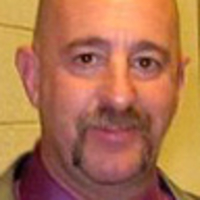I was at the house to kill a snitch, a drug enforcer who’d told some people I had a machine gun. I had been snorting cocaine and drinking scotch for 24 hours when I kicked the back door open and sprayed the kitchen with bullets. He scrambled out a window and ran to a neighbor’s house. A five-hour standoff ensued, during which I fired over 200 shots at the police before running out of bullets and coke.

When all was said and done, the judge sent me away for 22 ½ to 45 years. Many lives could have vanished that day, including mine—and my future son’s.
I was only 23 and already a career criminal, involved in extorting drug dealers, running an underground fight club, and providing muscle to a local slumlord for bouncing deadbeat tenants. My childhood dream was to go out in a blaze of gunfire like James Cagney; instead, I was rotting in a New Hampshire prison. When the prison teacher handed me my Adult Basic Education test scores showing I had the academic aptitude of a seventh grader, I was humiliated. Determined to change this, I got my GED, my high school diploma, and then a paralegal degree through a correspondence course, all while behind bars. It turned out I had a knack for practicing law, not just breaking it.
I went on to earn Bachelors and Masters degrees. Impressed with my efforts, the convicting judge from my shooting trial appeared in the same courtroom where he’d sentenced me 17 years earlier and advocated for my release. The remaining five years of my sentence were cut, and once free, I found your typical post-prison gigs – dishwasher, roofer – scraping by, often working for other former felons.
But my new life hadn’t yet begun. That day came at a gas station in Manchester, New Hampshire, where I ran into the sister of a girl who had a crush on me before I went to prison. Christina was younger and we’d never dated. But she was there the day of the standoff with the cops, and wrote me while I was in prison for a few years before moving on with her life and getting married. Seventeen years later, her sister told me she was getting a divorce. We met, and soon afterward, we married.
Then came our son Giovanni, and that all-consuming parental love I’d always heard about. Only mine was different – I’d once lost a daughter to an adoption thanks to a spiteful girlfriend who moved to terminate my parental rights. After that experience I resolved I would never lose another child. Each time I held Giovanni our bond grew stronger, my desire to protect him greater.
But something was wrong. Giovanni was vomiting everything he ate. He had chronic diarrhea, and his skin was shedding like a snake’s. By the time he was six weeks old Giovanni was deathly ill. We were bounced from hospital to hospital in search of a cure, or even a diagnosis. Our son was five months old when doctors at Boston Children’s Hospital delivered the horrifying news: Giovanni would die before his first birthday if he didn’t get a bone marrow transplant. They told us he had NEMO, a rare genetic disease. Only a handful of such diagnoses were confirmed worldwide. If we could find a match in the bone marrow registry, my son had a 50/50 chance of living. I asked the odds of finding a match. One in 20,000, a doctor told me.
“No problem,” I said. “I’ll put 20,000 people in the registry.”
I started the “Save Giovanni” campaign with flyers -- pictures of my son with IVs in his chest and his arm. I hung them in storefronts in Concord, where they were seen by a local reporter who wrote a story about us. More local papers put Giovanni on page one. The messenger of a well-known mobster called me, offering to hold a fundraiser for us. (I respectfully declined.) A Local 17 tin knocker working in Boston Children’s Hospital wanted to help. He had lost a 13-year-old daughter to cancer, and he rallied the Teamsters, Laborers, and Iron Workers unions, as well as the mayors of three cities and the Irish-American Club. Southie and Charlestown guys I had been in prison with threw me some part-time work, and the unions pooled money to pay the mortgage on our home for several months. Our collective efforts poured thousands of people into the registry. The head of the SWAT team who had given the green light to shoot me back at the house in New Hampshire joined me in organizing a bone marrow drive for my boy.
In the end, a cord-blood match was located for Giovanni, saving his life. But in many ways, the search for a donor itself saved mine. Today I’m a dedicated activist for marrow donation. I’ve helped register over 40,000 people, an effort that has saved dozens of strangers’ lives. I believe every individual is responsible for getting registered as a donor.
Donating marrow doesn’t hurt – that’s a myth that has kept potential donors away. Seventy percent of the time donating marrow is no more painful than donating blood. Yet many decline to make this easy sacrifice. Sacrificing for others is the purpose of life – that’s what Giovanni taught me. To save my son I became a bone marrow warrior. By surviving, the child redeemed the father.





